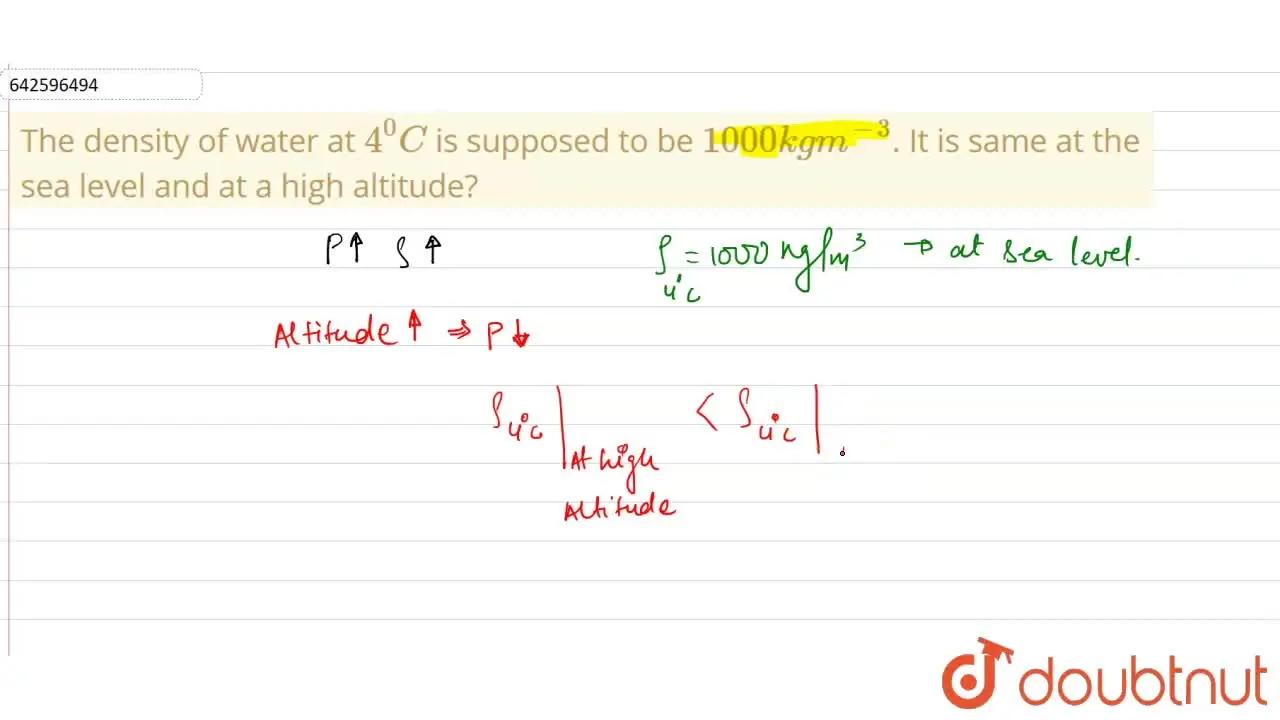The density of water at 40C is supposed to be 1000kgm−3. It is same at the sea level and at a high altitude?
Step by step video & image solution for The density of water at 4^0C is supposed to be 1000 kg m^(-3). It is same at the sea level and at a high altitude? by Physics experts to help you in doubts & scoring excellent marks in Class 11 exams.
Related Playlists
- BOOK - HC VERMA ENGLISHCHAPTER - HEAT AND TEMPERATUREEXERCISE - Objective 26videos
HEAT AND TEMPERATURE
- BOOK - HC VERMA ENGLISHCHAPTER - HEAT AND TEMPERATUREEXERCISE - Exercise34videos
HEAT AND TEMPERATURE
- BOOK - HC VERMA ENGLISHCHAPTER - GRAVITATIONEXERCISE - Question for short Answers18videos
GRAVITATION
- BOOK - HC VERMA ENGLISHCHAPTER - HEAT TRANSFEREXERCISE - QUESTIONS FOR SHORT ANSWER11videos
HEAT TRANSFER
Similar Questions
Calculate the molarity of water if its density is 1000kgm−3
View SolutionThe density of water is ........ kg/m3.
View SolutionThe density of the atmosphere at sea level is 1.29kg/m3. Assume that it does not change with altitude, how high should the atmosphere extend?
View SolutionThe density of the atmosphere at sea level is 1.29kg/m3. Assume that it does not change with altitude. Then how high would the atmosphere extend ? g=9.8ms−2. Atmospheric pressure =1.013×105Pa.
View SolutionThe density of water at 0∘C is 0.998gcm−3 at 4∘C is 1.00gcm−3. Calculate the average coefficient of volume expansion of water in the temperature range 0∘C to 4∘C.
View Solutioncalculate the increase in internal energy of 1 kg of water at 100oC when it is converted into steam at the same temperature and at 1atm (100 kPa). The density of water and steam are 1000 kg m−3 and 0.6 kg m−3 respectively. The latent heat of vaporization of water =2.25×106Jkg1.
View Solution1000 kg/m3 is equal to ........
View SolutionAssuming the density of air to be 1.295kg m−3, find the fall in barometric height in mm of Hg at a height of 107m above the sea level. Take density of mercury = 13.6×103kg m−3 .
View SolutionThe increase in internal energy of 1 kg of water at 100∘ C when it is converted into steam at the same temperature and 1 atm (100 kPa) will be :
[The density of water and steam are 1000kg/m3and0.6kg/m3 respectively. The latent heat of vapourisation of water is 2.25×106J/kg.]View SolutionA rain drop with radus 1.5 mm falls from a cloud at a height 1200 m from ground . The density of water is 1000 kg/m3 and density of air is 1.2kg/m3. Assume the drop was spherical throughout the fall and there is no air drag. The impact speed of the drop will be :
View Solution


